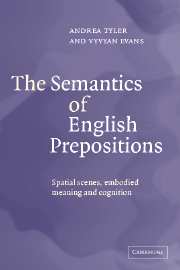Book contents
- Frontmatter
- Content
- Preface
- Acknowledgements
- 1 The nature of meaning
- 2 Embodied meaning and spatial experience
- 3 Towards a model of principled polysemy: spatial scenes and conceptualization
- 4 The semantic network for over
- 5 The vertical axis
- 6 Spatial particles of orientation
- 7 Bounded landmarks
- 8 Conclusion
- References
- Index
8 - Conclusion
Published online by Cambridge University Press: 22 September 2009
- Frontmatter
- Content
- Preface
- Acknowledgements
- 1 The nature of meaning
- 2 Embodied meaning and spatial experience
- 3 Towards a model of principled polysemy: spatial scenes and conceptualization
- 4 The semantic network for over
- 5 The vertical axis
- 6 Spatial particles of orientation
- 7 Bounded landmarks
- 8 Conclusion
- References
- Index
Summary
The focus of this investigation has been to account for the wide array of meanings associated with English spatial particles. In contrast to most previous investigations of spatial particles, we have been particularly concerned with the many non-spatial meanings associated with theseforms. The hypothesis that English spatial particles are polysemous (as opposed to homosemous or monosemous) and therefore that the many-to-one mappings between meanings and form are largely systematic is central to our analysis. In the course of this exploration, we have developed a model which we term principled polysemy.
The principled polysemy model takes a number of key assumptions about language as foundational. Many of these assumptions are more general in nature and must be recognized by any serious approach to language; others are informed by the perspective of cognitive linguistics. The approach rests fundamentally on the assumption that the primary reason humans use language is to communicate with one another and that this motivation constrains semantic extensions in non-trivial ways. Moreover, when lexical items are uttered (or written), they do not occur in isolation. Rather, they are embedded in longer segments of language, that is, naturally occurring language is always contextualized. Language itself radically underdetermines the rich interpretations regularly assigned to naturally occurring utterances (e.g., Green, 1989; Grice, 1975; Gumperz, 1982).
- Type
- Chapter
- Information
- The Semantics of English PrepositionsSpatial Scenes, Embodied Meaning, and Cognition, pp. 229 - 237Publisher: Cambridge University PressPrint publication year: 2003



